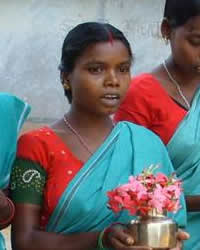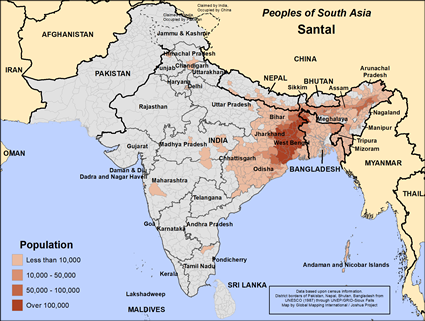The Santals are part of the Austro-Asiatic family, distantly related to the Vietnamese and Khmer. Historians believe that they were the ancestors of the tribal community residing in the eastern part of India (excluding the hill portions). The Santal language, Santali, belongs to the Munda (or Mundari) branch of the Austro-Asiatic language family. There are dialectical variations in Santali. The main dialectical distinction is between Northern Santali, which is spoken by the great majority of Santals, and Southern Santali. The latter is spoken in the southern part of Bihar and in Odisha, while Northern Santali is spoken in most of Bihar and in West Bengal. Prior to the 19th century, the basic Santal subsistence pattern was hunting/gathering, but with an ever-increasing population and the rapidly decreasing game supply, the Santals have turned to agriculture as their main source of food. The latest statistics say that the Santal are 6% believers. The Santal speak their own language of Santhali. The complete Bible and the JESUS Film are available in this language.
Today, the Santals are predominantly cereal agriculturists, growing rice as their chief crop, and further supplementing this with millet, sorghum, maize, and some vegetable crops. Cotton is grown for textile use. Santal agricultural methods are primarily of the slash-and-burn variety, with little knowledge or application of crop rotation, irrigation, or fertilizers. Hunting, fishing, and gathering are of less economic importance today. Cattle are raised to some extent, as well as sheep, goats, pigs, oxen, buffaloes, cows, cats, and dogs. These animals are used as supplementary sources of protein in the diet, as well as for other purposes (e. g., rodent control). The Santals trade extensively with neighboring Hindu peoples for the bulk of their everyday goods except for food stuffs and a forest products. Santal social organization is characterized by a lack of the caste separations so prominent in Hindu society, a patrilineal kinship system, and a relatively low level of political integration. The basic family unit is the extended patrilocal family. Each village is usually composed of a number of clans. The village is the key political unit, but the largest formally organized territorial unit is the "pargana", a loose confederation of approximately a dozen villages bound together to settle certain judicial questions and issues common to the Santal villages. The Santali culture has attracted many scholars and anthropologists for decades. The first attempt to study the Santali culture was done by Christian missionaries. The Santal people love music and dance. Like other Indian people groups, their culture has been influenced by mainstream Indian culture and by Western culture, but traditional music and dance still remain. Santal music differs from Hindustani classical music in significant ways. The Santal traditionally accompany many of their dances with two drums:the Tamak' and the Tumdak '. The flute was considered the most important Santal traditional instrument and still evokes feelings of nostalgia for many Santal. Santal dance and music traditionally revolved around Santal religious celebrations. This is still true to a degree although traditional religious beliefs have been significantly altered by Hindu belief and Christian mission work.
Traditionally, Santal religion was characterized by a belief in a pantheon of supernatural beings represented at the top by the supreme god Maran Buru. Their folk religion includes six other major gods and a host of nature and ancestral spirits. Although the Santals had no idols or temples, the Sacred Grove or Spring represented to them the place of residence of the supernatural powers, and it was there that prayers and sacrifices were made, usually by a village priest, to avert the ill will of the gods and to bring upon themselves, their crops, and their animals the blessings of the spirits. In addition, each family had two gods of its own, the orakbonga (household god) and the abgebonga (secret god), whose name was never divulged to anyone except the eldest son in the family. The bongas or spirits were generally friendly toward man, but at times could inflict misery and trouble. Hinduism has had only nominal influence on Santal religious practices as has Christianity, despite the fact that Christian missionaries have been functioning among the Santals since 1862. Although magic and witchcraft have also figured prominently in Santal religious practices, the Santals strongly believed in the existence of witches in the society, who, motivated by envy and operating through the medium of the evil eye or other magical practices, caused sickness, death, and other calamities upon members of the village community. By means of divinatory practices exercised through the offices of the witch-finder and the ojha (a kind of exorcist), the causative agents of the disease were determined and ritually removed, and the identity of the witch revealed. Once the name of the witch was known, that person was often beaten, fined, driven from the community, and frequently killed. Witches in Santal society were inevitably female, while the ojha and the witch-finders were male. The Santal community is devoid of any caste system and there is no distinction made on the basis of birth.
A tradition in Santal culture: A missionary named Stan Avery has traveled with native Indian missionaries throughout Santal territory, visiting churches and church planters. In December 2015, they met with Santali elders who told them they possess an ancient book, called the "Hapram Puthi", which contains their sacred histories. This book has never been translated into English.
"Our tribe knows what happened," the Santali elders told Avery and the missionaries with him. They referred to the Creation, the Flood, and the Tower of Babel, which their book describes, similar to Genesis.
Regarding the Flood, their book tells that a man, his wife, and his family survived by taking refuge in the highest cave on the highest mountain. God told him to take his family, and a pair of all animals, inside the cave, and so they did. The Flood destroyed everything in the entire world, and all the other people died. Later they came out and repopulated the world.17
Their ancient tome also records that, just a few generations after the Flood, people became evil again. They were trying to build this tower to get up to where God was. They all spoke one language at that time. But God decided to put a stop to their plan. So he gave each clan a different language, and they were scattered in confusion. "Our clan was given the Santali language. We traveled through the mountains and came here, where we now live."
The Santal people need to put all their trust in Jesus Christ so they can experience the abundant life that God offers. The Santal would benefit by medical teams who can share with them the benefits of modern medicine. The Santal church needs trained pastors who can teach them the Bible.
Pray for a spiritual hunger that will drive the Santal people to seek and find Jesus Christ. Pray for the Lord to send educational, medical and agricultural teams of believers to help the Santal with their physical needs. Pray for a disciple making movement to flourish among the Santal people this decade. Ask the Lord to establish the Santal believers in the Bible and that He would lead them to share their faith with their family and friends.
Scripture Prayers for the Santal (Sawntal) in India.
Cultural tradition courtesy of Nick Liguori
| Profile Source: Keith Carey |












